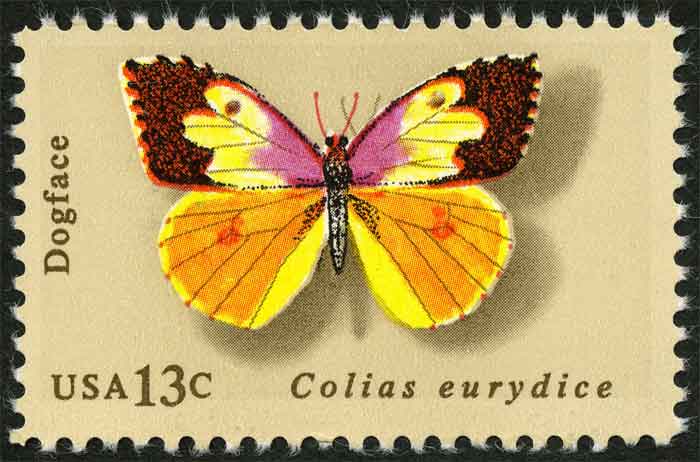
Zerene eurydice, Biology Stamps
Superregnum: Eukaryota
Regnum: Animalia
Subregnum: Eumetazoa
Cladus: Bilateria
Cladus: Nephrozoa
Cladus: Protostomia
Cladus: Ecdysozoa
Cladus: Panarthropoda
Phylum: Arthropoda
Subphylum: Hexapoda
Classis: Insecta
Cladus: Dicondylia
Subclassis: Pterygota
Cladus: Metapterygota
Infraclassis: Neoptera
Cladus: Eumetabola
Cladus: Endopterygota
Superordo: Panorpida
Cladus: Amphiesmenoptera
Ordo: Lepidoptera
Subordo: Glossata
Cladus: Coelolepida
Cladus: Myoglossata
Cladus: Neolepidoptera
Infraordo: Heteroneura
Cladus: Eulepidoptera
Cladus: Ditrysia
Cladus: Apoditrysia
Cladus: Obtectomera
Superfamilia: Papilionoidea
Familia: Pieridae
Subfamilia: Coliadinae
Genus: Zerene
Species: Z. eurydice
Zerene eurydice, the California dogface butterfly, belongs to the family Pieridae and is a member of a genus closely related to the genus Colias.[1] A study that collected mitochondrial DNA from various Colias butterfly species found that Z. eurydice had decreased divergence from the ingroup, highlighting how closely related these two genera are.[2] This species is endemic to California, and is California's state insect.[3] The California dogface butterfly varies in its wing color and pattern.
Description
The California dogface butterfly, gained its name as a result of the coloring of the wings of the butterfly, especially in the males. The female typically has yellow wings, with two black dots or dashes on each forewing, while the male has black on the outer edges of the forewing, usually enclosing a yellow-orange color and two black dots.[4] Male Z. Eurydice butterflies have an iridescent pigment found in their dorsal forewings due to light reflecting chitin structures and this has been associated with mating success.[5] The wing span of Zerene Eurydice measures about 5-6 cm.[6]
Distribution, feeding and habitat
Z. eurydice's distribution is limited to that of California and is commonly found in the San Bernardino mountains and Santa Ana Mountains in Southern California.[1] In addition to the mountains, the adult California dogface butterflies can often be seen in the California chaparral and woodlands habitats.[6]
Larvae of Z. eurydice exclusively feed on Amorpha californica, and Amorpha fruticosa, which belong to the family Fabaceae.[5] Adult butterflies are attracted to regions with moist soils and feed on several species of flowers.[4] It has been found that they are especially fond of blue gilia, sunflowers and thistle blooms.[4]
These butterflies fly very fast, and are difficult to approach unless they are nectaring at flowers.[4] As a result, it is a challenge to get a photograph of them with their wings open. This fast flight aids Z. eurydice in escaping from predators such as birds, frogs, snakes, lizards and wasps.[7] Z. Eurydice butterflies usually begin their flights around 7 a.m. and fly until the afternoon. This is not continuous and the butterflies will often roost in bushes. The females usually depart in flight an hour or two after the males.[4]
First state insect
The California dogface butterfly has been the state insect of the U.S. state of California since 1972.[3] Its endemic range is limited to the state. California was the first state to choose a state insect — and thus, to choose a butterfly — though most of the other states have now followed, and many even have both a state insect and state butterfly. It took 43 years, a determined 4th grade class and Fresno Assemblyman, Kenneth Maddy, to have the California Dogface butterfly designated as the state insect.[8]
See also
List of Lepidoptera that feed on Cirsium - thistles
References
Pacific Coast Entomological Society; Society, Pacific Coast Entomological; Van Duzee, Edward P.; Sciences, California Academy of; Society, Pacific Coast Entomological (1927). The Pan-Pacific entomologist. 4. San Francisco: Pacific Coast Entomological Society.
"A mitochondrial-DNA-based phylogeny for some evolutionary-genetic model species of Colias butterflies (Lepidoptera, Pieridae)". Molecular Phylogenetics and Evolution. 47 (3): 893–902. 2008-06-01. doi:10.1016/j.ympev.2008.03.013. ISSN 1055-7903.
California State Library Retrieved August 25, 2017.
Riddell, Janet (1941). "Some Remarkable Forms and Aberrations in the Subgenus Zerene Hübner (lepidoptera, Pieridae)". Transactions of the Royal Entomological Society of London. 91 (9): 447–457. doi:10.1111/j.1365-2311.1941.tb01047.x. ISSN 1365-2311.
Fenner, Jennifer; Rodriguez-Caro, Luis; Counterman, Brian (2019-07-01). "Plasticity and divergence in ultraviolet reflecting structures on Dogface butterfly wings". Arthropod Structure & Development. 51: 14–22. doi:10.1016/j.asd.2019.06.001. ISSN 1467-8039. PMID 31176003.
"California Dogface Zerene eurydice (Boisduval, 1855) | Butterflies and Moths of North America". www.butterfliesandmoths.org. Retrieved 2021-05-24.
Diamond, Sara; Hong, Kijun. "Zerene eurydice". Animal Diversity Web. Retrieved 2021-05-24.
"Butterfly Makes Good". The Sacramento Bee. August 1, 1972.
Retrieved from "http://en.wikipedia.org/"
All text is available under the terms of the GNU Free Documentation License

